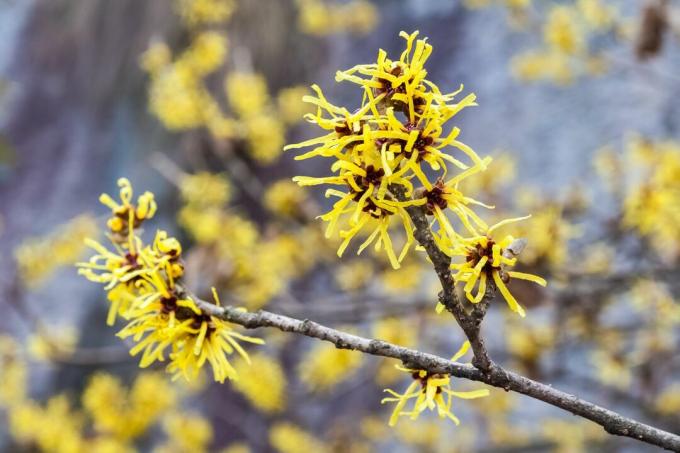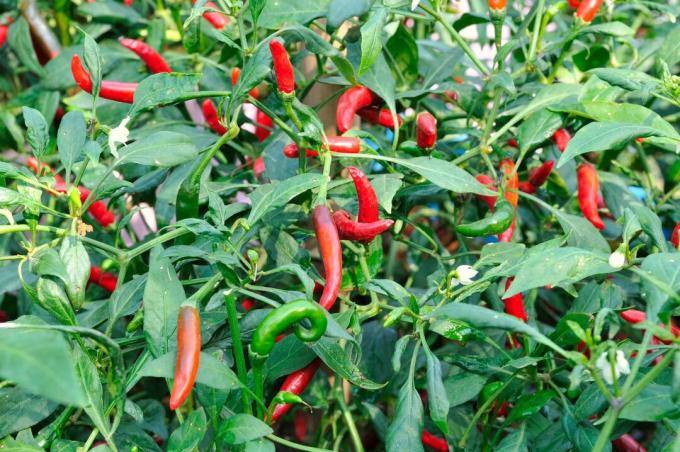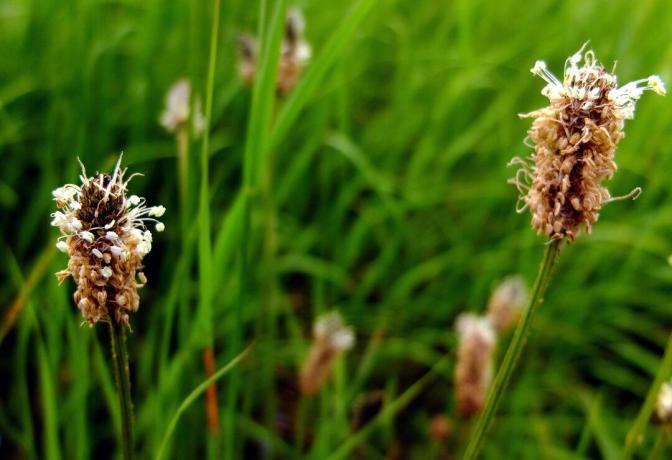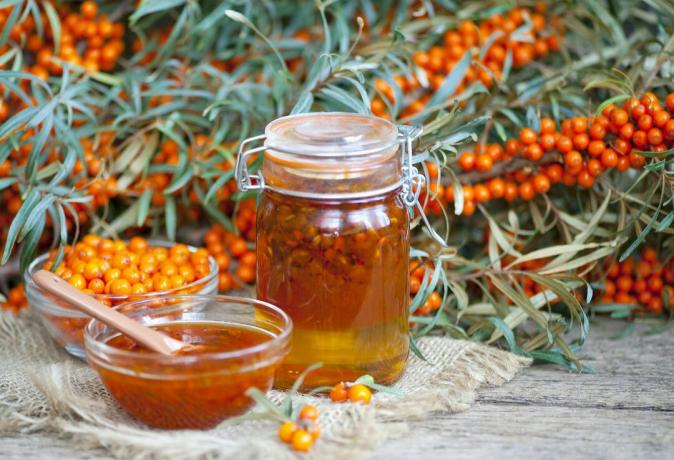The best active ingredients often come from nature. We present 10 plants with healing properties that are suitable for the production of natural cosmetics.

Medicinal plants with a particularly positive effect on the skin are often used in "green cosmetics" or natural cosmetics. But which plants are best for your own creams and ointments?
contents
-
Natural cosmetics from your own garden
- 1. Witch hazel
- 2. Aloe vera
- 3. Pansy
- 4. Marigold
- 5. chili
- 6. Johannis herbs
- 7. Ribwort plantain
- 8. lavender
- 9. Evening primrose
- 10. Sea buckthorn
Natural cosmetics from your own garden
Making natural cosmetics yourself at home is exactly in line with the trend towards conscious consumption and growing health awareness. With just a few materials such as beeswax, oils and the respective medicinal plants, you can quickly create your own hand cream. Gone are the days when you tried to decipher the chemical additives on the cosmetic package and had to ask yourself whether there weren't any undesirable effects. Many of our garden plants are ideal for processing in your own cosmetics because they have a healing and caring effect on our skin. We present the 10 best plants for this in the following.
1. Witch hazel
The elegant Witch hazel (Witch hazel) is one of the first flowering shrubs to develop their delicate yellow to deep red thread-like flowers as early as January. Their sweet smell and the wonderful red-gold color of the leaves in autumn make them a popular and long-lived garden dweller. In their native North America, the Cherokee Indians have used it as a medicinal plant for centuries. Unfortunately, we are still barely aware of its positive properties. The leaves and bark of the witch hazel can be used for extracts and ointments. Your plant substances work against itching and burning or weeping areas of the skin. They also stop minor bleeding and promote wound healing. The witch hazel also unfolds its effect as so-called "aqua hamamelidis", i.e. as an aqueous extract in the form of shaving and facial tonic.

2. Aloe vera
The well-known houseplant is undemanding and resilient, as it comes from the tropics and subtropics. The real aloe (Aloe vera) has thickened leaves filled with water tissue and small, bleached teeth on the leaf margin at regular intervals. With its own water supply, it is perfectly adapted to longer dry periods. The slimy gel that escapes when you cut it has valuable ingredients and can therefore also be used for natural cosmetics. For all skin injuries, especially burns, the gel has a cooling and pain-relieving effect and at the same time promotes the healing of the wound. Their anti-inflammatory and antiseptic effects are also used for neurodermatitis, psoriasis and eczema. To make a cooling gel, older leaves are cut off and placed upright in a glass for some time to separate the unwanted yellow juice from the gel. Then the leaves are peeled and the water tissue they contain is pureed to a homogeneous mass. Vitamin C powder is added for preservation so that the gel can be kept for up to four weeks.

3. Pansy
The small Pansy (viola) can be found in many house gardens. They appear again and again in the bed in all possible color combinations and not only inspire hobby gardeners. The edible flowers of the viola processed or candied as a whole and used as an ornament for many dishes. However, it is often unknown that the pansy also has a healing effect. For atopic dermatitis, internal and external eczema, as well as mild acne and scars, creams and ointments made from Viola have proven themselves. Since the plant is particularly gentle, it is also suitable for babies and toddlers, with cradle cap or diaper rash. For external and internal use, a tea can simply be made from whole, dried plants. In this form, the viola also has an anti-inflammatory effect in gout and rheumatic diseases. During the flowering period in May and June, the whole plant is harvested and gently dried in the air.

4. Marigold
The orange to lemon yellow Marigold (Calendula officinalis) belongs to the Asteraceae family and is an annual ornamental plant in many gardens. The pretty flowers can be found as a splash of color in herbal and flower tea mixtures. The skin-healing effect of this plant is famous, however, and therefore many lotions and oils with marigold extracts can also be found in commercial natural cosmetics. Marigold oil is used especially for wounds that do not heal well or for massage. You fill a screw jar with fresh or better dried flowers and cover them with high-quality vegetable oil. The oil is left to soak in the sun for a few weeks before it is strained and either used directly or processed.

5. chili
An ointment can be used for sore muscles or tension chili (Capsicum sp.) to provide relief. The hot fruits from the nightshade family (Solanaceae) is known as a condiment in the kitchen or as a loyal roommate in the pot. The alkaloid capsaicin is responsible for the warming and sometimes fiery effect. In the different chilli varieties it is represented in different concentrations, which are measured using the so-called Scoville scale. If you put finely chopped chillies in high-quality vegetable oil and leave the closed container to stand for a few weeks, you have produced an effective chilli oil with little effort. This can be used directly for warming massages or processed into balm and ointment. Tips and tricks on how to make your chillies really hot for natural cosmetics or for the kitchen, You will find here.

6. Johannis herbs
The real Johannis herbs (Hypericum perforatum) is a perennial herbaceous plant with sun-yellow five-fold flowers that begins to bloom around St. John's Day - i.e. the end of June. If you hold the oval leaves up to the light, you can see many small translucent oil glands that give the plant its botanical nickname perforatum ("Perforated") gave. If you rub the young buds and flowers between your fingers, the dark red active ingredient hypericin appears. We owe this substance also the healing effect, on the one hand on the skin and on the other hand in depressive moods. The oil from the flowers is also colored deep red and is therefore also called red oil. St. John's wort ointments work very well on tension, inflammation and cracked skin as well as shingles and neurodermatitis. However, the hypericin does cause some drug interactions and should therefore only be used in consultation with a doctor.

7. Ribwort plantain
The inconspicuous one Ribwort plantain (Plantago lanceolata) appears to some as a weed, as it prefers to inhabit stony, barren soils, meadows and also crevices between stone slabs. It is a perennial plant that forms small inconspicuous but graceful flowers on long stems between May and September. But the small plant with the long, pointed leaves has it all. In the case of insect bites and burns, the ribwort is an emergency first aid. If you chew the leaves into a pulp and spread them over the wound, they relieve itching and pain. The ribwort soothes puffiness, bruises and bruises. An ointment made from the freshly harvested leaves lasts for a few months and brings you safely through the mosquito and wasp-rich times in midsummer.

8. lavender
One of our most popular garden plants is the lavender (Lavandula angustifolia), which attracts numerous insects with its intense scent and deep purple to white flowers. The perennial, herbaceous plant loves well drained, sandy-stony soils and sunny locations. The aromatic scent has been proven to have a calming and relaxing effect as well as against nervousness. Its anti-inflammatory and antiseptic properties relieve insect bites and abrasions, as well as eczema and rashes. Annoying mosquitoes as Aphids and Moths keeps the lavender scent away. It is precisely these healing effects that are best captured in a lavender ointment. For this you ideally use gently dried flowers, which are allowed to soak in an oil-wax mixture for a few days before heating and straining the whole thing again. A hydrosol, i.e. a water extract with essential oil, can be used as a spray for sleep disorders and skin problems as a gentle agent. For the hydrosol, fresh flowers are placed in a pot on a vegetable insert; a small glass bowl is placed in the middle of the sieve. As with cooking vegetables, there should be enough water to evaporate. Instead of a lid, a large, rounded bowl with ice water is placed on the pot. The water evaporates and absorbs the active ingredients and scent of the lavender, rises to the top and condenses on the cold bowl. The hydrosol drips into the center of the small bowl and can be filled later.

9. Evening primrose
the Evening primrose (Oenothera) lives up to its name and only opens its white, lemon-yellow or pink to purple-colored petals shortly after sunset within a few minutes. Therefore it is an interesting food source for many moths. It originally comes from America, but has been spreading as a neophyte here for some time. In dry and warm locations, the evening primrose can reach a height of up to two meters. The seeds of this biennial plant have a special healing effect. They contain a lot of valuable oil with gamma-linolenic acid, which has a very positive effect on eczema, neurodermatitis, general skin complaints and rheumatic diseases. Using an oil extract from the grated seeds, you can make day creams, body lotions or ointments that you can care for yourself. Other dried plant parts can also be used in natural cosmetics.

10. Sea buckthorn
The prickly sea buckthorn (Hippophae rhamnoides) is considered a pioneer plant because it is one of the first when free space is available. This extremely undemanding plant even thrives on scree slopes and gravelly or barren soils. In autumn, the light orange round fruits adorn the branches in masses and only become ripe for consumption with the frost. The pseudo-stone fruit has an extremely high vitamin C content, which makes sea buckthorn a popular addition to juice, smoothies and dietary supplements. But the sea buckthorn is also good for our skin: Sea buckthorn relieves neurodermatitis, increases skin health and accelerates the healing of wounds. An oil extract is made from the pureed fruits, which can later be used for ointments and creams. The vitamin A from the orange dye also protects against solar radiation and reduces the formation of wrinkles.

If you are also interested in other medicinal plants in our gardens and their uses, please visit our article on the 10 best medicinal plants.



